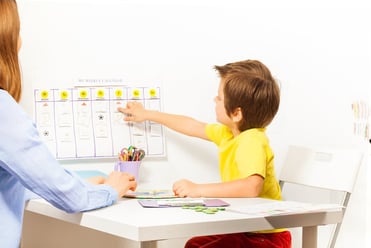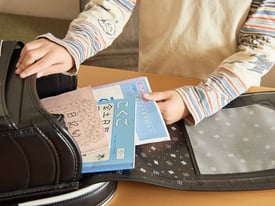How to Strengthen Executive Functioning Skills for Autistic Children
Executive functioning is a fundamental process that each person needs to achieve goals, filter distractions, prioritize tasks, and control impulses. Deficits in executive functioning will impact a person’s ability to get through the daily tasks of the day effectively. Nearly everything we do calls on a component of executive function.
Executive functioning disorder is a common occurrence within the autism community, with some research indicating that executive functioning disorder may occur in more than 80% of autistic children.1 Discrepancies in executive functioning can be especially problematic. Our goal as educators is to get our students to become as independent as possible. We must teach strategies to our students to ensure that they can overcome deficits they may have in executive functions.
Organization, planning, attention, working memory, and self-control all fall under the umbrella of executive functioning. Each component plays a vital role in developing a self-sufficient and independent child. Our job is to identify what problems our students may be facing in executive functioning and come up with a plan to alleviate their difficulties. Luckily, these skills can be taught and nurtured in our classrooms.
Working Memory
Notoriously, autistic individuals often have specific memory strengths. Some can easily remember and store information regarding a topic of interest. However, some may struggle to execute the tasks to complete common life skills, such as brushing their teeth or getting dressed in the morning. Working memory is essential and needed to accomplish daily tasks.

Working Memory Ideas for the Classroom:
- Play games such as memory or telephone.
- Chunk information into smaller parts.
- Use visuals to support a topic.
- Make a checklist of steps for a task.
- Use concise language.
- Reteach and review tough lessons.
- Use gestures to support an activity.
- Have the student make connections to their lives.
- Continue to review mastered skills.
- Limit distractions in the classroom.
- Teach students to picture the idea you’re working on mentally.
Organization
Many students struggle with the skill of organization. It can be especially problematic for autistic students. Children need to execute organization to ensure that they can efficiently arrange materials and thoughts in an orderly fashion. I’ve found while teaching that autistic students do so much better when the classroom is organized.
Organization Ideas for the Classroom:
 Label important areas and things in the classroom.
Label important areas and things in the classroom. - Use visuals to scaffold more significant tasks, such as unpacking a bookbag or completing a multi-step worksheet.
- Make sure everything has a place in the classroom.
- Color code the student’s materials: All the students in my class, have an assigned color, and it corresponds to their schedules, cubbies, and work boxes.
- Use schedules and make sure the students are aware of the sequence of events for the day; Make sure to make the students are aware of changes to the schedule.
- Ensure that you and your staff are prepared for the day.
- Teach organization and model organization regularly.
Attention
Autistic students often have a keen aptitude to focus on specific topics, but directing that focus can be difficult. Maintaining attention during activities is fundamental to learning. Autistic children can be easily distracted by outside stimuli and may struggle to comprehend critical information while distracted. Teaching strategies that promote attention will better ensure that the student understands the information being taught.
Attention Ideas for the Classroom:
- Use favorite topics during instruction. For example, if the student is interested in SpongeBob, use that character during teaching.
“SpongeBob is helping Patrick collect seashells. SpongeBob found seven shells, and Patrick found four shells. How many shells did the friends collect together?”
-
Use flexible seating options to guarantee the student gets enough sensory feedback while learning, promoting attention. Note: STAGES® Learning has some tremendous flexible seating options.
- Less is more for autistic students. Don’t over-decorate the room, keep it simple and limit distractions.
- Use timers or transition cues.
- Teach and model active attention.
- Meet sensory needs to warrant attention; allow students to use fidgets.
- Keep directions simple. Instead of saying, “I want you to put the shapes together to make a match,” say instead, “Match the shapes.”
- Repeat critical words or directives.
- Use first-then language, visuals, or both to support tasks.
“First open the book bag, then take out the folder.”
- Play games that encourage attention:
-
- Sound bingo
-
- Red Light, Green Light
-
- Simon Says
-
- Hot Potato
-
- Freeze Dance
-
- Musical Chairs
-
- And so many more!
- Make it fun and exciting for our students.
Planning
 A student’s ability to think of the future, create a plan, and prioritize is an important area of cognitive development. In the classroom, planning encompasses time management and getting work done. Sometimes neurodivergent individuals struggle to formulate plans and can get “stuck” in the here and now. To reach necessary goals, individuals need to execute the function of planning.
A student’s ability to think of the future, create a plan, and prioritize is an important area of cognitive development. In the classroom, planning encompasses time management and getting work done. Sometimes neurodivergent individuals struggle to formulate plans and can get “stuck” in the here and now. To reach necessary goals, individuals need to execute the function of planning.
Planning Ideas for the Classroom:
- Discuss with families and students the goals they would like to accomplish.
- Create a step-by-step plan to achieve the goals. Frequently go over that plan with the student.
- Make sure the goals are attainable.
- Take data and use data to support results.
- Give choices and explain the outcomes of specific decisions.
- Create a self-monitoring checklist for your student.
- Allow students to use timers to stay on-task.
- Encourage movement breaks.
- Use task analysis and a structured curriculum designed specifically for autistic children, such as the ARIS® Academic Readiness Intervention System, to plan instruction.
Problem-Solving
Some autistic individuals struggle to regulate their emotions or actions. The ability to solve a problem is a significant component of being successful. Neurodivergent individuals may find it challenging to navigate some social situations, and practical problem-solving can essentially make those social situations more manageable.
Problem Solving Ideas for the Classroom:
- Use visual supports to demonstrate emotions and social situations.
- Act out and model social situations.
- Teach the ability to make choices.
- Allow students to take a break.
- Have an area in the classroom to facilitate calming.
- Teach students and model how to self-talk a problem.
- Have calming tools available for students. These tools can include but aren’t limited to music, headphones, fidgets, and slime.
- Use the zones of regulation.
- Create a social story for a difficult social situation.
- Use social scripts.
- Practice problem-solving.
- Teach students to be aware of their triggers.
- Have staff be aware of student’s triggers.
- Use reinforcement to encourage positive behaviors.
- Make the classroom a calm and safe place.

Our daily lives rely on executive functioning. Autistic students may struggle with deficits in executive functioning. However, with the proper support and strategies, they can successfully close the gaps and lead a productive life.
I think we can all improve our executive functioning skills. I know I can be easily distracted by outside stimuli while working and need quiet to write or read. Please share some helpful ideas about what has worked for you or your child or student in developing stronger executive functioning skills. Thanks!
References
1. See, for example, Alsaedi, et. al, Behavioral and Neuropsychological Evaluation of Executive Functions in Children with Autism Spectrum Disorder in the Gulf Region
Brain Sci. 2020, 10, 120; doi:10.3390/brainsci10020120

Tatiana Tortora
Tatiana Tortora is a special education teacher in New York, specifically teaching students on the spectrum. She has her master’s degree in childhood education and students with disabilities. Tatiana is passionate about building understanding and acceptance of individuals with Autism.





